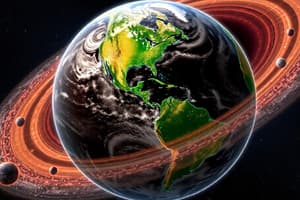Podcast
Questions and Answers
Which statement accurately describes the characteristics of terrestrial planets?
Which statement accurately describes the characteristics of terrestrial planets?
- They are large and gaseous with many moons.
- They rotate slowly and possess prominent rings.
- They are primarily composed of hydrogen and helium.
- They have high densities and are poor in ices. (correct)
What is a distinctive feature of the outer planets compared to the inner planets?
What is a distinctive feature of the outer planets compared to the inner planets?
- They are rocky and poor in gases.
- They rotate rapidly and have many moons. (correct)
- They are located closer to the sun than terrestrial planets.
- They are smaller and have higher densities.
What is the density range for gaseous outer planets?
What is the density range for gaseous outer planets?
- 3.9 g/cm³ or more
- 1.6 g/cm³ or less (correct)
- Approximately 2.5 g/cm³
- Between 4.0 g/cm³ and 6.0 g/cm³
Which of the following planets is classified as a terrestrial planet?
Which of the following planets is classified as a terrestrial planet?
How do the densities of inner planets compare to those of outer planets?
How do the densities of inner planets compare to those of outer planets?
Which location is home to some of the oldest known rocks on Earth?
Which location is home to some of the oldest known rocks on Earth?
What percentage of the Earth's surface is covered by the hydrosphere?
What percentage of the Earth's surface is covered by the hydrosphere?
Which of the following is NOT one of the Earth's spheres?
Which of the following is NOT one of the Earth's spheres?
What percentage of the Earth's atmosphere is composed of nitrogen?
What percentage of the Earth's atmosphere is composed of nitrogen?
Which layer of the atmosphere is primarily responsible for the occurrence of weather?
Which layer of the atmosphere is primarily responsible for the occurrence of weather?
What types of rocks compose the Earth's crust?
What types of rocks compose the Earth's crust?
Which of the following statements about the hydrosphere is true?
Which of the following statements about the hydrosphere is true?
Which atmospheric layer contains the ozone layer responsible for filtering UV rays?
Which atmospheric layer contains the ozone layer responsible for filtering UV rays?
Which of the following gases is NOT a major component of the Earth's atmosphere?
Which of the following gases is NOT a major component of the Earth's atmosphere?
What is the correct order of the atmospheric layers starting from the Earth's surface?
What is the correct order of the atmospheric layers starting from the Earth's surface?
What is the maximum depth reached by the deepest well drilled in the Earth's crust?
What is the maximum depth reached by the deepest well drilled in the Earth's crust?
What is the approximate maximum thickness of the continental crust?
What is the approximate maximum thickness of the continental crust?
What is the approximate temperature at the bottom of the deepest well drilled into the Earth's crust?
What is the approximate temperature at the bottom of the deepest well drilled into the Earth's crust?
What type of rock fragments are known as xenoliths?
What type of rock fragments are known as xenoliths?
Which characteristic best describes the density of oceanic crust?
Which characteristic best describes the density of oceanic crust?
Which layer of the Earth is part of the lithosphere?
Which layer of the Earth is part of the lithosphere?
Which method is NOT typically used to study the Earth's interior?
Which method is NOT typically used to study the Earth's interior?
Which of the following statements about the asthenosphere is correct?
Which of the following statements about the asthenosphere is correct?
Which of the following statements about volcanic activity is true?
Which of the following statements about volcanic activity is true?
What is the estimated age of the oceanic crust?
What is the estimated age of the oceanic crust?
Which of the following statements accurately characterizes the Earth's Crust?
Which of the following statements accurately characterizes the Earth's Crust?
What determines the classification of Earth's layers based on physical properties?
What determines the classification of Earth's layers based on physical properties?
What role does self-gravity play in the formation of celestial bodies according to the Nebular Theory?
What role does self-gravity play in the formation of celestial bodies according to the Nebular Theory?
Which layer of the Earth is characterized as the outermost compositional layer?
Which layer of the Earth is characterized as the outermost compositional layer?
How does the conservation of angular momentum affect a gas cloud in the context of the Nebular Theory?
How does the conservation of angular momentum affect a gas cloud in the context of the Nebular Theory?
What is the primary composition of oceanic crust?
What is the primary composition of oceanic crust?
What is the estimated age of the Earth based on radiometric dating techniques?
What is the estimated age of the Earth based on radiometric dating techniques?
Which incorrectly describes the physical layers of the Earth?
Which incorrectly describes the physical layers of the Earth?
What happens when centrifugal force balances gravitational forces in the formation process?
What happens when centrifugal force balances gravitational forces in the formation process?
Which instrument is primarily used for radiometric dating to estimate the age of Earth?
Which instrument is primarily used for radiometric dating to estimate the age of Earth?
What primarily composes the Earth's core?
What primarily composes the Earth's core?
What is the state of matter of the inner core due to extreme pressure?
What is the state of matter of the inner core due to extreme pressure?
Which of the following descriptions about the Earth's core is accurate?
Which of the following descriptions about the Earth's core is accurate?
In terms of volume, how does the core compare to other layers of the Earth?
In terms of volume, how does the core compare to other layers of the Earth?
How does the mass of the Earth's core relate to the overall mass of the planet?
How does the mass of the Earth's core relate to the overall mass of the planet?
Flashcards
Inner Planets
Inner Planets
Rocky planets close to the sun (Mercury, Venus, Earth, and Mars).
Outer Planets
Outer Planets
Large, gaseous planets further from the sun (Jupiter, Saturn, Uranus, Neptune).
Terrestrial Planets
Terrestrial Planets
The inner planets: rocky, small, high-density, little ice or rings
Jovian Planets
Jovian Planets
Signup and view all the flashcards
Inner Planet Density
Inner Planet Density
Signup and view all the flashcards
Outer Planet Density
Outer Planet Density
Signup and view all the flashcards
Solar System
Solar System
Signup and view all the flashcards
Nebular Theory
Nebular Theory
Signup and view all the flashcards
Self-gravity
Self-gravity
Signup and view all the flashcards
Conservation of angular momentum
Conservation of angular momentum
Signup and view all the flashcards
Proto-sun
Proto-sun
Signup and view all the flashcards
Centrifugal force
Centrifugal force
Signup and view all the flashcards
Disk formation
Disk formation
Signup and view all the flashcards
Planet formation
Planet formation
Signup and view all the flashcards
Earth's age
Earth's age
Signup and view all the flashcards
Radiometric dating
Radiometric dating
Signup and view all the flashcards
Biosphere
Biosphere
Signup and view all the flashcards
Atmosphere Composition
Atmosphere Composition
Signup and view all the flashcards
Troposphere
Troposphere
Signup and view all the flashcards
Stratosphere
Stratosphere
Signup and view all the flashcards
Atmosphere Layers
Atmosphere Layers
Signup and view all the flashcards
Oldest Earth Rocks
Oldest Earth Rocks
Signup and view all the flashcards
Even Older Rocks
Even Older Rocks
Signup and view all the flashcards
Earth's Spheres
Earth's Spheres
Signup and view all the flashcards
Earth's Crust
Earth's Crust
Signup and view all the flashcards
Hydrosphere Composition
Hydrosphere Composition
Signup and view all the flashcards
Earth's Compositional Layers
Earth's Compositional Layers
Signup and view all the flashcards
Crust
Crust
Signup and view all the flashcards
Mantle
Mantle
Signup and view all the flashcards
Core
Core
Signup and view all the flashcards
Continental Crust
Continental Crust
Signup and view all the flashcards
Oceanic Crust
Oceanic Crust
Signup and view all the flashcards
Earth's Layers
Earth's Layers
Signup and view all the flashcards
Earth's Interior
Earth's Interior
Signup and view all the flashcards
Drilling
Drilling
Signup and view all the flashcards
Soviet Well
Soviet Well
Signup and view all the flashcards
Xenolith
Xenolith
Signup and view all the flashcards
Volcanic Activity (sample)
Volcanic Activity (sample)
Signup and view all the flashcards
Seismic waves
Seismic waves
Signup and view all the flashcards
Meteorites
Meteorites
Signup and view all the flashcards
Earth's Core Composition
Earth's Core Composition
Signup and view all the flashcards
Earth's Core Temperature
Earth's Core Temperature
Signup and view all the flashcards
Inner Core State
Inner Core State
Signup and view all the flashcards
Outer Core State
Outer Core State
Signup and view all the flashcards
Mantle's Mass vs. Volume
Mantle's Mass vs. Volume
Signup and view all the flashcards
Core's Mass vs. Volume
Core's Mass vs. Volume
Signup and view all the flashcards
Atmosphere Mass
Atmosphere Mass
Signup and view all the flashcards
Ocean Mass
Ocean Mass
Signup and view all the flashcards
Crust Mass
Crust Mass
Signup and view all the flashcards
Continental Crust Thickness
Continental Crust Thickness
Signup and view all the flashcards
Continental Crust Density
Continental Crust Density
Signup and view all the flashcards
Continental Crust Age
Continental Crust Age
Signup and view all the flashcards
Oceanic Crust Thickness
Oceanic Crust Thickness
Signup and view all the flashcards
Oceanic Crust Density
Oceanic Crust Density
Signup and view all the flashcards
Oceanic Crust Age
Oceanic Crust Age
Signup and view all the flashcards
Asthenosphere
Asthenosphere
Signup and view all the flashcards
Physical Layer: Lithosphere
Physical Layer: Lithosphere
Signup and view all the flashcards
Physical Layer: Mantle
Physical Layer: Mantle
Signup and view all the flashcards
Earth's Layers
Earth's Layers
Signup and view all the flashcards




